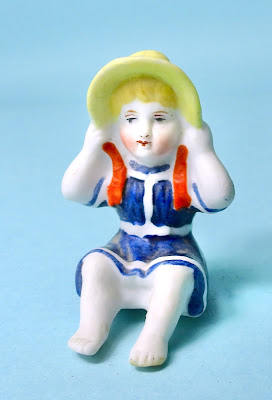Postcard Image

Thursday, December 21, 2023
Gorgeous Goebel
Friday, December 8, 2023
William Goebel's Wonderful Water-Folk
I have an article on the online Museum of Aquarium and Pet History discussing the lovely loreleis and whimsical water creatures created by the German firm of William Goebel.
Thursday, November 30, 2023
Impudent Imposter
Thursday, November 16, 2023
And This Little Piggy. . .
. . . hit the beach. This glamorous gilt is another example of a pink pig fairing, popular from the late 1800s through the turn of the last century. She is part of an entire genre of bisque and china figurines featuring pink pigs engaged in typically human activities, often with a comical or satirical theme. This pulchritudinous porker has decided to bake her hams at the seaside, daintily descending from a bathing machine in her pink bathing suit bedecked with bows. Of excellent sharp bisque, this piece is five inches high and incised "4673" on the back. The top of the bathing machine is open to serve as a vase.
Monday, November 6, 2023
Who Made These Mermaids?
Friday, October 27, 2023
Casting a Wide Net
This laughing lass has her net at ready, perhaps hoping to bag herself some handsome beach beau. She is actually made to perch on the edge of an aquarium, a variation on the fish bowl fancies with fishing poles. Although by the 1920s the form-fitting wool knit swimsuit was becoming popular, many women still wore bathing suits like this one, consisting of a long shift-like tunic top over shorts.
Although unmarked, I attribute her to the German firm of Hertwig and Company. Not only are her sharp realistic modeling and lively expression similar to this company's bathing beauties and lithe lady figurines, there is a hole on the bottom that would have accommodated a metal loop to clip the piece to the rim of an aquarium. Hertwig used such clips for its fishing figures, but these metal clips are often missing, having fallen out or rusted away over the decades. This lass is 6 inches tall, quite large for this sort of aquarium ornament.
Friday, October 6, 2023
Pleased as Punch!
Thursday, September 14, 2023
Gone Fishing!
On May 4, 2023, my article about fishing figures, the little aquarium novelties that perched on the edge of a fishtanks, tiny fishing poles in hand, appeared on the on the online Museum of Aquarium and Pet History. The article includes pictures of these fish tank fancies from my collection, as well as images from manufacturer and aquarium catalogs.
Friday, August 18, 2023
At Last. . . a Man!*
Thursday, July 13, 2023
Pony Boy

Thursday, June 15, 2023
Automaton Odalisque (Updated June 16, 2023)
Friday, June 2, 2023
Someone Needs a Hug. . . .
Thursday, May 11, 2023
Gayly Sounds the Castanet,
Thursday, April 27, 2023
Age of Bronze, Finale
Friday, March 31, 2023
Age of Bronze II
Friday, March 17, 2023
Age of Bronze
This lissome miss is cast in bronze. Although only 2.5 inches tall and high, she is superbly sculpted, from the waves in her thick tresses to the tiny bows on the toes of her ballet-style bathing slippers. Her skin has a soft glowing golden patina, while the nautical blouse of her bathing suit is subtly silvered and her skirt and shoes have a greenish patina. A touch of red tints the bows in her hair and around her slender ankles. Although unmarked, this bronze beach belle is most likely Austrian. Beginning in the mid-19th century, Vienna became the center of many foundries and ateliers producing a wide array of finely crafted artistic bronzes to adorn the homes of those wishing to subtly display their taste and wealth. Although pretty and petite, she is surprisingly heavy for her small size and perhaps could have served as a paperweight for a gentleman's desk.













.jpeg)


























